|
Monuments in Hulst
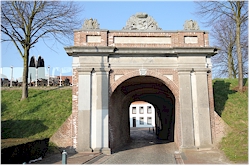 The
town walls of Hulst.
Hulst is known as a fortified town; it is one of the few places
in the Low Countries that still has its town walls virtually
intact. They are not only nice to see from an strategic
and architectural point-of-view but they are also very pleasant
for a walk. The historic center of the town is situated
completely inside these walls that still completely encircle it.
These fortifications are the largest monument of Hulst and in
their present state, they still largely date back to the
80 Years War [more
info]. The
town walls of Hulst.
Hulst is known as a fortified town; it is one of the few places
in the Low Countries that still has its town walls virtually
intact. They are not only nice to see from an strategic
and architectural point-of-view but they are also very pleasant
for a walk. The historic center of the town is situated
completely inside these walls that still completely encircle it.
These fortifications are the largest monument of Hulst and in
their present state, they still largely date back to the
80 Years War [more
info].
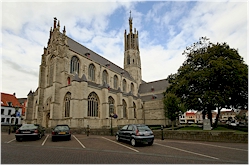 The
basilica of Saint-Willibrordus.
Construction of this gothic church
started in 1200 but it would take untill 1534 for it to be
completed, at the dawn of the religious troubles and
iconoclastic fury. Once the catholic Spaniards were driven
out of Hulst in 1645 (80 Years War), the church passed on to the
protestants. This situation remained until the French
occupation under Napoleon (1806) when the church was split in
two parts: one half for the protestants, the other for the
catholics [more
info] The
basilica of Saint-Willibrordus.
Construction of this gothic church
started in 1200 but it would take untill 1534 for it to be
completed, at the dawn of the religious troubles and
iconoclastic fury. Once the catholic Spaniards were driven
out of Hulst in 1645 (80 Years War), the church passed on to the
protestants. This situation remained until the French
occupation under Napoleon (1806) when the church was split in
two parts: one half for the protestants, the other for the
catholics [more
info]
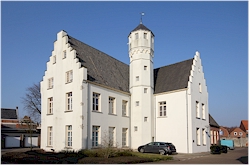 The
Refuges of Hulst.
A refuge is, as the word implies, a
house that was built by religious orders where they could take
shelter in case of emergency. These refuges were
constructed in fortified towns. When there was danger,
monks could leave their farmsteads on the countryside behind to
these safe places, safely behind the walls of the town.
There were also refuges in Hulst. Three of those houses
are still there: Baudeloo, Cambron and Ter Duinen. They
are some of the most beautiful edifices in the town [more
info] The
Refuges of Hulst.
A refuge is, as the word implies, a
house that was built by religious orders where they could take
shelter in case of emergency. These refuges were
constructed in fortified towns. When there was danger,
monks could leave their farmsteads on the countryside behind to
these safe places, safely behind the walls of the town.
There were also refuges in Hulst. Three of those houses
are still there: Baudeloo, Cambron and Ter Duinen. They
are some of the most beautiful edifices in the town [more
info]
 The
town hall of Hulst.
The beautiful, proud town
hall of Hulst is located centrally on the 'Grote Markt' (the
main market square). The slender tower is very
characteristic. It was built between 1528 and 1534 on the
spot where there used to be a hall. The historic town hall
can be visited. The
town hall of Hulst.
The beautiful, proud town
hall of Hulst is located centrally on the 'Grote Markt' (the
main market square). The slender tower is very
characteristic. It was built between 1528 and 1534 on the
spot where there used to be a hall. The historic town hall
can be visited.
Address: Grote Markt.
's Landshuis.
This is one of the nicest historic buildings in the town.
This monumental house was built in the 17th century and was used
for governmental purposes. More specifically it was the
house of the magistrate of the 'Ambacht Hulst' (that consists of
the territory of Hulst and three other surrounding communities).
Nowadays the tourist office (VVV) is situated here.
Address: Steenstraat 37
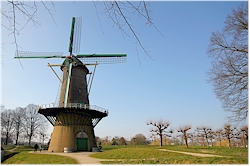 Town
mill.
The town mill is a stone mill with gallery built in 1792.
The sails can be turned into the wind at the top. It was
initially erected to provide food for the town's garrison of
soldiers. Later on the mill passed into private hands;
nowadays the town owns the windmill and made it operational
again. Town
mill.
The town mill is a stone mill with gallery built in 1792.
The sails can be turned into the wind at the top. It was
initially erected to provide food for the town's garrison of
soldiers. Later on the mill passed into private hands;
nowadays the town owns the windmill and made it operational
again.
Location: Molenbastion
.
|

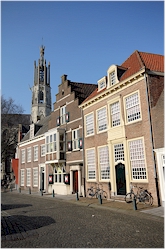




 Town
mill.
The town mill is a stone mill with gallery built in 1792.
The sails can be turned into the wind at the top. It was
initially erected to provide food for the town's garrison of
soldiers. Later on the mill passed into private hands;
nowadays the town owns the windmill and made it operational
again.
Town
mill.
The town mill is a stone mill with gallery built in 1792.
The sails can be turned into the wind at the top. It was
initially erected to provide food for the town's garrison of
soldiers. Later on the mill passed into private hands;
nowadays the town owns the windmill and made it operational
again.